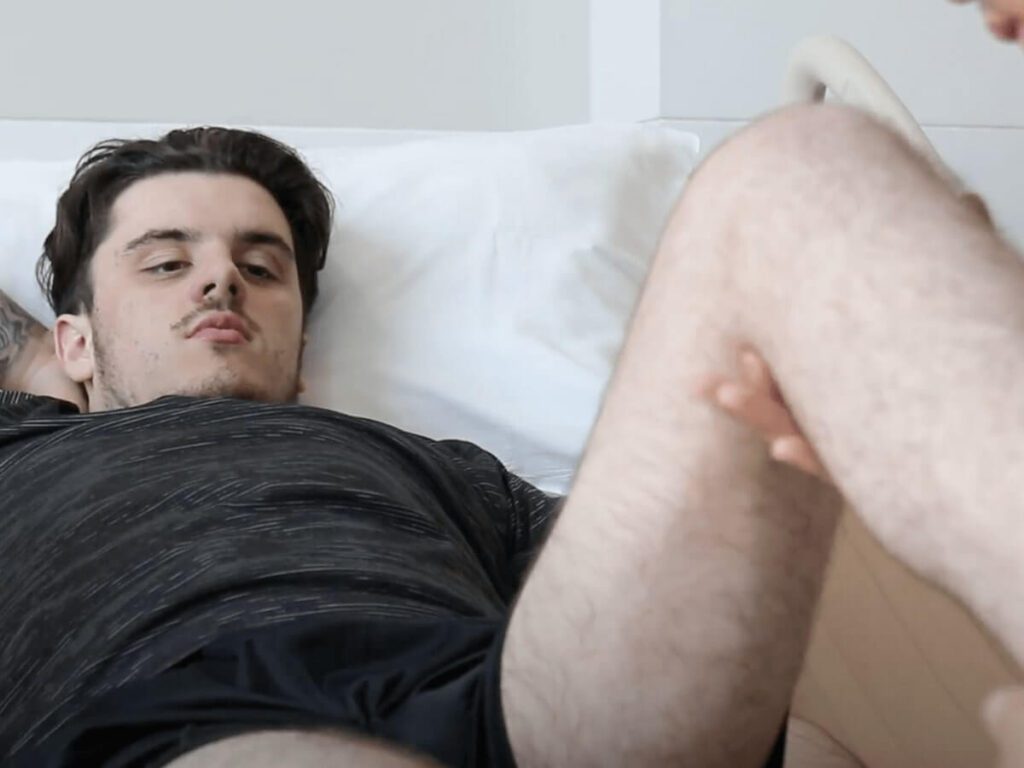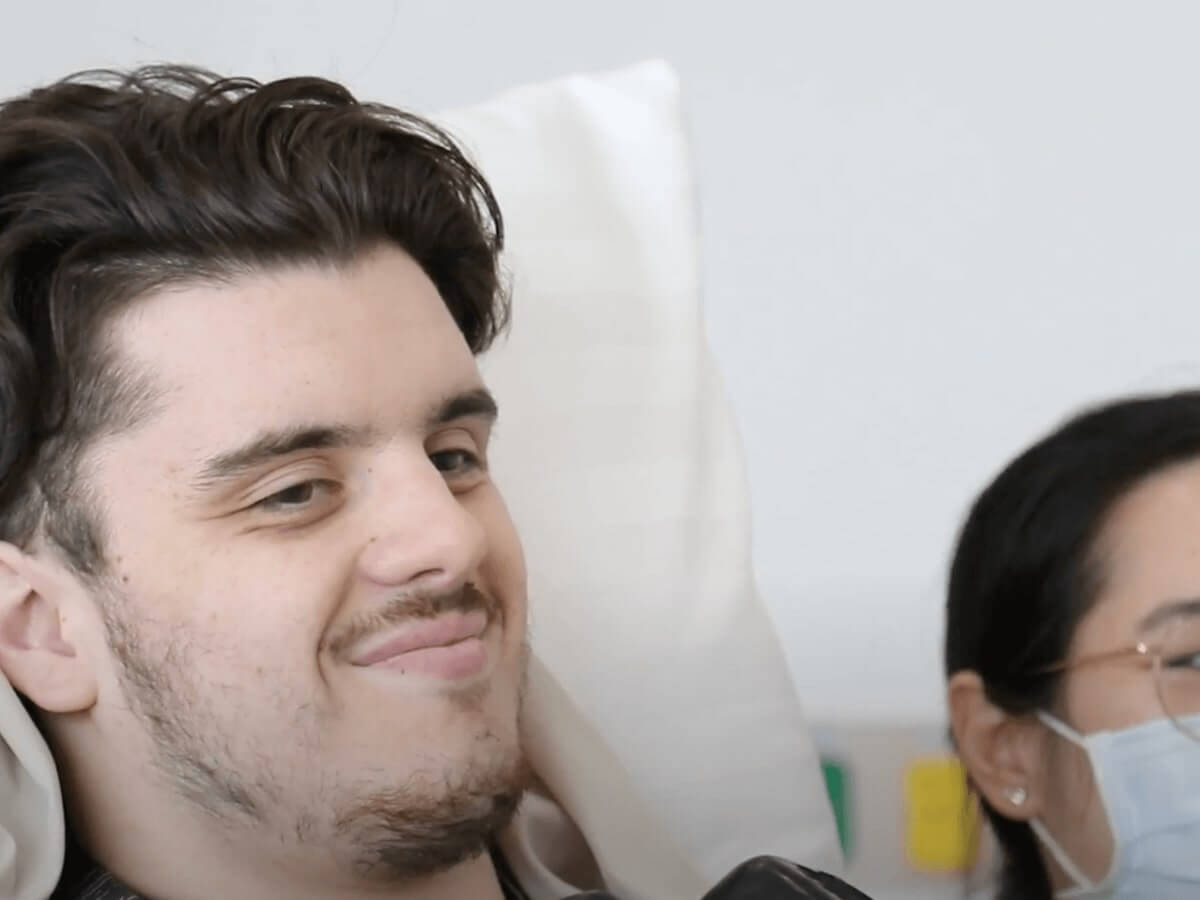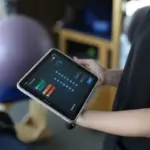Improving core strength is a big focus in treating spinal cord injuries, as it contributes to the regaining of many functions. In his second progress interview, Ryan Straschnitzki, who received epidural stimulation treatment for spinal cord injury, covers the benefits he has seen to his core, as well as other insights. With Hanna Charles, Director of Patient Representatives, he covers a number of topics, including the workings of the stimulator and how to qualify for the treatment.
Hello again everyone, this is Hanna from Verita Neuro, here for our next weekly update. Congratulations on your first steps Ryan, how does it feel?
It feels unreal! I mean, it’s not something I'm used to doing in the past year and a half so to see myself doing it on camera, it's pretty amazing, and it's all thanks to the people here.
Yes, exactly. We have lots of questions!
Yes, exactly. We have lots of questions!
The first one asks what is your injury, was it complete or incomplete, and what ASIA scoring was it? How was it initially compared to now?
So my injuries are T2-T3 incomplete. I'm not sure on the ASIA scoring, I don't really believe in that stuff. I think anything is possible and just because they do a little bit of testing with the poking and the rubbing, I don't think that can dictate what your injury can be. So for me, I focus on T2 - T3 incomplete. Now after the stimulation, I feel many improvements in my core and lower body functions, I'm able to do more things than I was before.
Ok, so another question - How are the gains so far? How long did the improvements take to appear?
So I've been here for about two and a half weeks now, and I have another two and a half weeks to go. I’ve done lots of physio. Obviously, the surgery was right away as soon as I got here and they've been pushing me harder ever since I've been here. So I think that's important to get better and I’ve got a long way to go. The improvements appear right away. I mean, a few days after we tried the stimulator, I was able to move my legs.

What is required for the maintenance of the device, for example if something goes wrong or the battery needs charging? Is there somewhere local that can support this?
The device works via this remote that’s Bluetooth. Basically, there are different programs set for different functions and activities. There's a portable charger that you can use - it plugs into the controller, wraps around the body, and goes right over the top of the device, and that way the charging doesn't take too long - maybe an hour or so - and then you're able to use it for as long as you want.
Yes, exactly. It's wirelessly charged. Usually, the battery life is estimated at nine years. This is quite some time and honestly, the patient who has worked the longest with us so far, it's been a little less than five years so we’ve never had a case where we need to replace the device. This is a Medtronic device, they’re one of the biggest companies manufacturing medical devices in the world. They are originally from the USA but they have offices and technical support teams in almost every country. When it comes to device mapping and fine-tuning, this is something we have to do here in Thailand, because it requires a specific skill set that our therapists have. It's still a treatment that is not widely available, so for any remapping or adjustment, we recommend patients to come back to us.
Yes, exactly. It's wirelessly charged. Usually, the battery life is estimated at nine years. This is quite some time and honestly, the patient who has worked the longest with us so far, it's been a little less than five years so we’ve never had a case where we need to replace the device. This is a Medtronic device, they’re one of the biggest companies manufacturing medical devices in the world. They are originally from the USA but they have offices and technical support teams in almost every country. When it comes to device mapping and fine-tuning, this is something we have to do here in Thailand, because it requires a specific skill set that our therapists have. It's still a treatment that is not widely available, so for any remapping or adjustment, we recommend patients to come back to us.
So the remote you're using, how do you use it? Do you use it to activate the movement?
There are different stimulators inside, there are 16 electrodes. They do the mapping here and they set different programs. Today I'm learning how to use different skill sets and programs on the remote. There's different activities such as walking, stepping, riding a bike - there's a lot of programs, I think there's millions and millions of combinations. They're gonna teach me how to do it.
If you were to name the areas that the treatment improved in your day-to-day life the most, what would it be?
I think that core function helps out a lot. I mean, not having a core after such a high-level injury, you're always worried about having to grab onto things and trying to not fall out of your chair. So for me, I think having a core balance helps out a ton. Every day, things get easier, such as picking things up or having to transfer things from counter to table. It’s continuing to improve through physio as well. They really push you to your limits and make you use that stimulator carefully, not just as much as you'd like, so you’re using more of your body functions. Without the stimulator, if you’re getting those functional movements down, it's only going to improve when the stimulator is on.
Is it possible to retain the movement in the future without the stimulator? This is still not confirmed. We haven't been doing this for very long, but we are already noticing that some patients do start to regain functions without the help of a simulator. One patient of ours, six months post epidural stimulation, was able to stand up and lock her knees without the stimulator being on. But this it’s quite early, usually we expect it to take at least a few years for that to happen. We have an overnight program. This is a very mild stimulation we're using to help the spinal nerves and the spinal cord to regenerate to a certain extent.
So we have another question asking if you have any nerve pain or spasticity since you’ve received the epidural stimulation?
I have but there are set programs to get rid of that and I think the reason for this device being used medically is actually to get rid of nerve pain as well. So it's slowly going down and of course, that comes with taking away some meds that I'm on, which are not easy to get off. But I think this device can definitely help. Before the surgery I used to have quite a few spasms - it was getting in the way of life sometimes, transferring and or even trying to lay down I’d get lots of spasms. After using the stimulator, there's certain programs that can take it away and obviously using those muscles they're going to get stronger and the spasms can get stronger, but with a program, it can kind of mitigate that.
Yes, initially the spasticity can increase slightly. This is because the stimulation creates more activity in the spine. Long term we see that the stimulator can reduce the spasticity quite significantly in some patients.
Yes, initially the spasticity can increase slightly. This is because the stimulation creates more activity in the spine. Long term we see that the stimulator can reduce the spasticity quite significantly in some patients.
How did you qualify - what reports were needed?
Well, I was a young person and my injury was pretty recent so I was within that two-year frame. I know there's a certain level of injury that you have to be within to qualify - I’m not too sure of the qualifications, but I think the main reason I was eligible was because the injury was so recent.
I can elaborate on this - the process is not complicated. We treat patients with different injury levels, starting with C-level injuries where we can also work on upper body functions. We can place two stimulators or one, for the upper body or the lower body, so any injuries usually from C4 to T10/T11 could qualify for epidural stimulation. The most important thing is to review the MRI images. We need the original images, to take a look at the injury and assess the chances. A small part of the spinal cord has to be connected, just to allow brain signals to be delivered to the electrode and the stimulator. But we do treat both complete and incomplete injuries - even if someone is diagnosed with a complete injury, there’s still a chance that there are connected fibers. We can evaluate each case and we do it free of cost, so whoever's interested in this can reach out and send us their MRI images to review.
I can elaborate on this - the process is not complicated. We treat patients with different injury levels, starting with C-level injuries where we can also work on upper body functions. We can place two stimulators or one, for the upper body or the lower body, so any injuries usually from C4 to T10/T11 could qualify for epidural stimulation. The most important thing is to review the MRI images. We need the original images, to take a look at the injury and assess the chances. A small part of the spinal cord has to be connected, just to allow brain signals to be delivered to the electrode and the stimulator. But we do treat both complete and incomplete injuries - even if someone is diagnosed with a complete injury, there’s still a chance that there are connected fibers. We can evaluate each case and we do it free of cost, so whoever's interested in this can reach out and send us their MRI images to review.
So another question, when will the mapping be available in Canada?
This is something we would like to achieve. Unfortunately, learning how to do the mapping is a very complicated process. To prepare a therapist to work functionally with a patient requires many months of training. But it's definitely on our to-do list.
I think we talked about this last week. I think Canada is or was a little behind in this sort of area and I think it'll take a while for them to actually get things going the way they have it set up here. The good thing is that there are already some physiotherapy centers that know how to work with epidural stimulation patients. They don’t do mapping, but they do know how to do physio exercises with the epidural stimulator. I’m attending Synaptic rehab. They provide resources to healthcare professionals and work hand in hand with individuals who have had Epidural Stimulation surgery.
Yes! Also, we work very closely with our patients after they return home. We prepare a treatment plan with videos of how to perform certain exercises, along with the training plan. It shows what to do each day, how many times per week, how many hours and how many repetitions for each exercise. We try to support the physiotherapy centers to work with our patients and we are in touch for at least one year so we're always available.
I think we talked about this last week. I think Canada is or was a little behind in this sort of area and I think it'll take a while for them to actually get things going the way they have it set up here. The good thing is that there are already some physiotherapy centers that know how to work with epidural stimulation patients. They don’t do mapping, but they do know how to do physio exercises with the epidural stimulator. I’m attending Synaptic rehab. They provide resources to healthcare professionals and work hand in hand with individuals who have had Epidural Stimulation surgery.
Yes! Also, we work very closely with our patients after they return home. We prepare a treatment plan with videos of how to perform certain exercises, along with the training plan. It shows what to do each day, how many times per week, how many hours and how many repetitions for each exercise. We try to support the physiotherapy centers to work with our patients and we are in touch for at least one year so we're always available.
Thank you, everyone, and we will be live again next week, discussing the treatment and taking some more questions!
The above is not a verbatim transcript of Ryan’s interview and the exact wording and order of words have been edited to be read more easily. You can watch the full interview on our Facebook channel.





